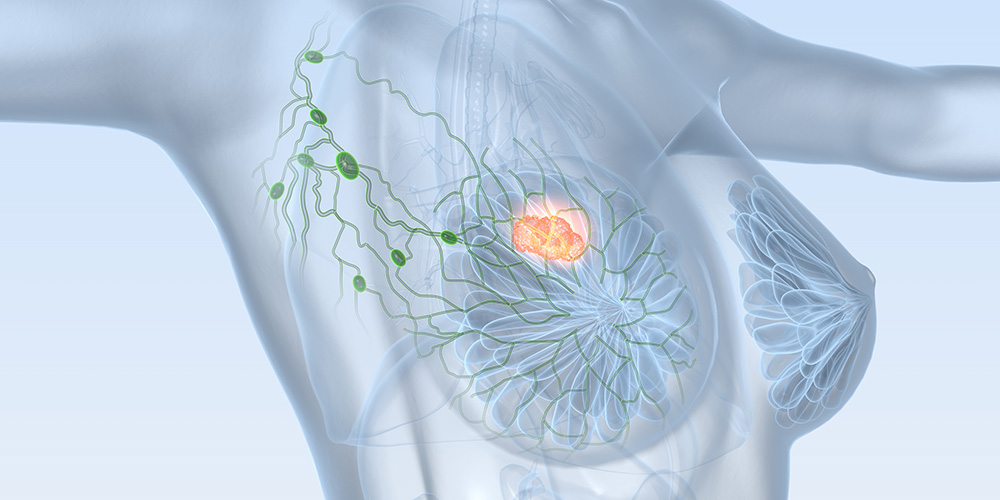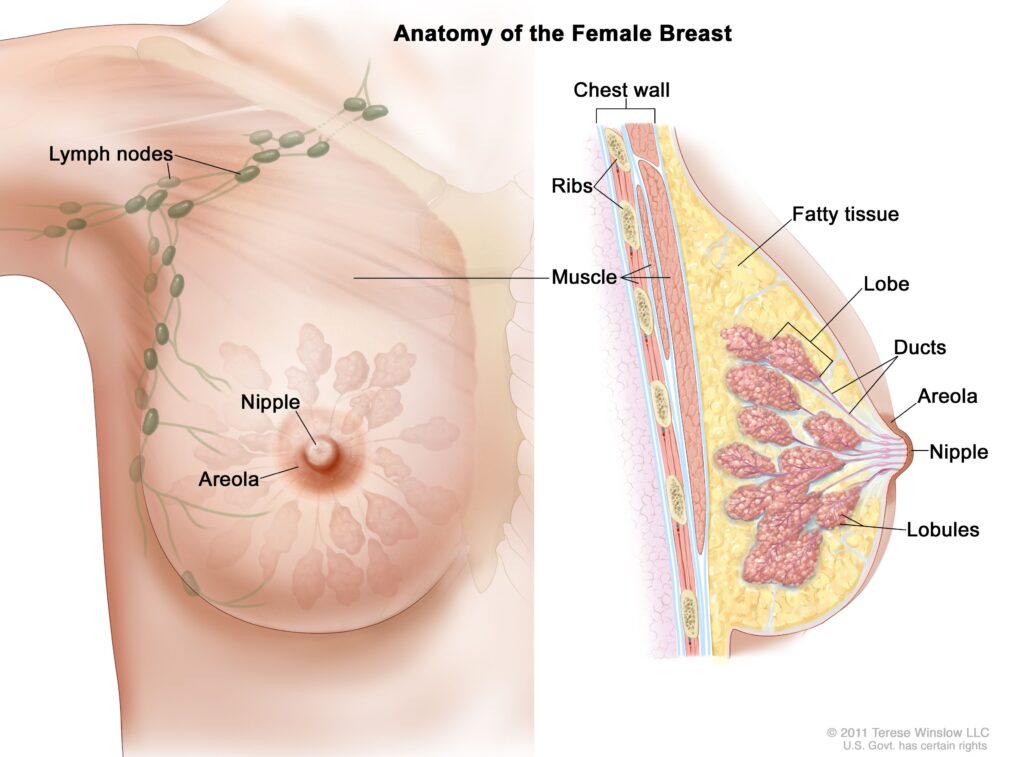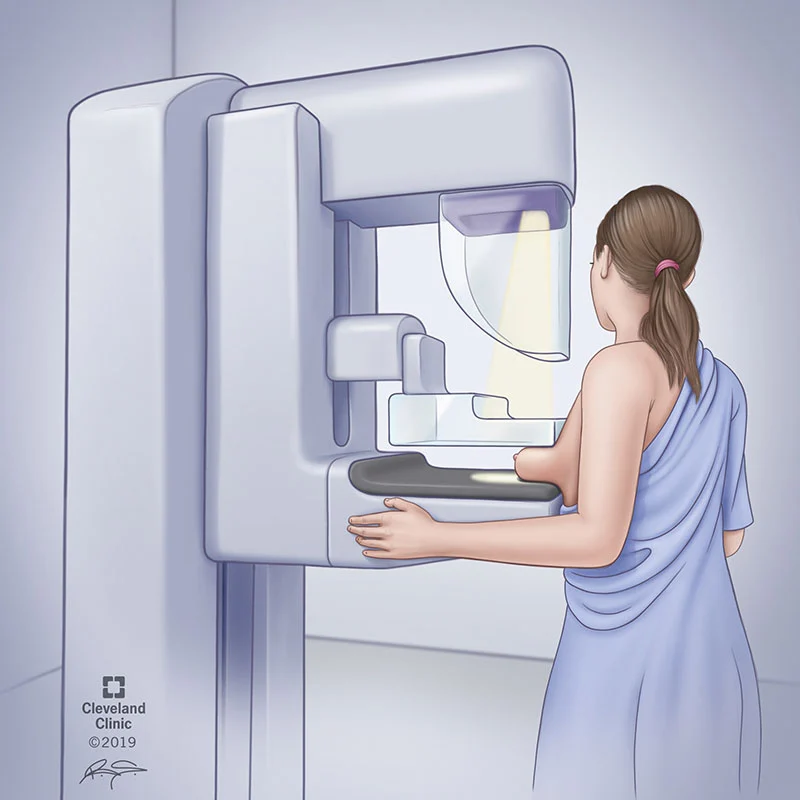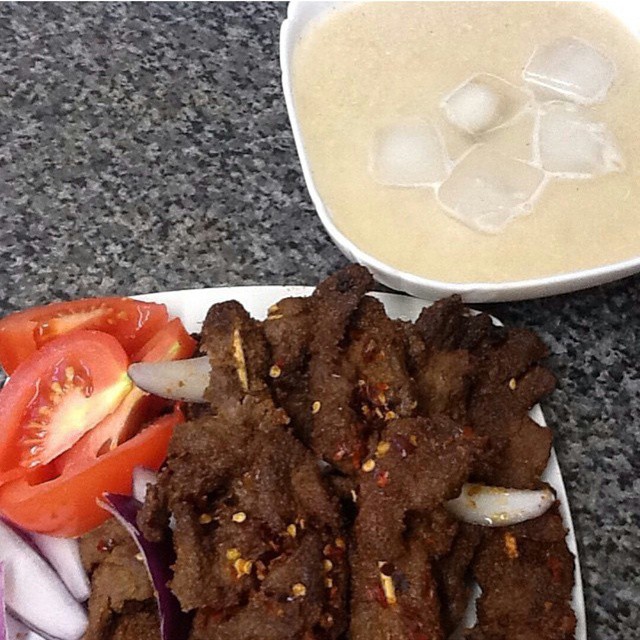Breast cancer is a disease that occurs when healthy breast cells become abnormal, grow out of control, and form tumours. It can begin in the milk ducts or lobules of the breast. Sometimes, this disease can spread to other parts of the body.
Although the risk for breast cancer differs, both men and women can develop this disease. About 1 in 8 women have a lifetime risk of getting this disease. On the other hand, for men, the risk is 1 in 1000.

Normal Structure of The Breast
The breasts contain fatty tissue containing small chambers called lobules where breast milk is made. The milk travels through tiny channels called ducts to reach the nipples. Lymph nodes are located inside your breast and under your arms. Lymph vessels connect these nodes, helping your body fight disease.

What Are The Signs and Symptoms of Breast Cancer?
The following are signs of breast cancer. You should seek medical attention if you notice;
- Lump(s) in the breast or armpit
- Change in breast shape or size
- Nipple changes (caved in/pulled out)
- Nipple discharge (clear or bloody)
- Redness of breast skin
- Dimpling of the breast skin (appears like the orange fruit skin)
Are There Risk Factors?
Yes, you are more likely to develop cancer in your breasts due to the following risk factors;
- Older age
- Dense breasts
- Having breast cancer before
- Family history of the disease
- Inherited genetic mutations
- Alcohol use
- Overweight or obesity
How Can You Screen for Breast Cancer?
Screening can help detect cancer in your breasts. You can screen for this disease in the following ways;
- Self-breast examination – You can check your own breasts at about the same time each month at home. Start by feeling your breasts and armpits, one at a time. You should look out for the signs previously highlighted.
- Clinical breast examination by your doctor
- Screening mammography

How is Breast Cancer Diagnosed?
Diagnostic tests for cancer in the breasts vary. Your doctor will use a method that applies to your cancer stage, symptoms, and family history.
- Diagnostic mammography – This test is employed when abnormalities are seen on a screening mammogram.
- Breast ultrasound scan – This can identify if a suspicious lump is fluid-filled or solid. A fluid-filled lump is often benign and a cyst, while a solid one may be cancerous or a fibrous growth.
- Breast magnetic resonance imaging (MRI) – This shows more details than the mammogram.
- Breast biopsy – This involves the removal of a small amount of tissue from the breast. There are various types of biopsy. A specialist doctor called a pathologist will analyze the breast tissue sample by looking at it under the microscope and doing specific tests. Their report will inform the diagnosis of cancer. The result of this test helps the doctor to choose your treatment.
Stages of Breast Cancer
Breast cancer occurs in stages 0 – IV. These stages are influenced by several factors, such as the size and location of the cancer and its spread to other areas of the body.
How is Breast Cancer Treated?
Treatment for cancer in the breasts depends on the stage of the disease. Breast cancer stages are between 0 and IV. Generally, it takes a team of specialists, including a surgeon, radiotherapist, and pathologist, to treat the disease.
The main treatment options are:
- Surgery
- Radiation therapy
- Chemotherapy
- Hormone therapy
- Targeted therapy
- Combination treatments
What is Metastatic Breast Cancer?
This is a type of cancer that has spread from the breast to other areas of the body. The most common areas are the liver, bones, lungs, and brain. Sadly, there is no cure for this type of cancer, and treatment can only prolong survival.
Fortunately, advanced treatment options have made it possible for people with the metastatic form of this cancer to live for up to 5 years and even more. Metastatic breast cancer treatment may include ongoing chemotherapy, hormone therapy, targeted therapy, and immunotherapy.
A Word from HealthFacts to You
It is frightening to learn you have breast cancer. However, the information available can help you to receive timely, individualized, and effective treatment that can give you the best chance of being cured. Always ask your doctor questions.
Till next time, stay informed and stay healthy!
Suggested Reading: 6 Breast Cancer myths you need to trash










I don’t even know how I ended up here, but I thought this post was great. I do not know who you are but definitely you are going to a famous blogger if you aren’t already 😉 Cheers!
Hey there! This is my first comment here so I just wanted to give a quick shout out and say I really enjoy reading your articles. Can you recommend any other blogs/websites/forums that deal with the same subjects? Thanks a lot!
Throughout this great scheme of things you receive an A+ just for hard work. Where you confused me personally ended up being in your facts. You know, it is said, the devil is in the details… And it could not be much more accurate at this point. Having said that, let me tell you what exactly did give good results. The article (parts of it) is definitely pretty engaging and this is most likely why I am making the effort in order to comment. I do not really make it a regular habit of doing that. 2nd, whilst I can notice a jumps in logic you make, I am not convinced of how you appear to connect your points that help to make your final result. For now I will subscribe to your position but wish in the future you connect the dots better.
Hello there! Do you use Twitter? I’d like to follow you if that would be okay. I’m definitely enjoying your blog and look forward to new updates.
Have you ever considered writing an ebook or guest authoring on other websites? I have a blog based upon on the same ideas you discuss and would really like to have you share some stories/information. I know my audience would enjoy your work. If you are even remotely interested, feel free to send me an e mail.
Thanks for finally writing about > Understanding Breast Cancer – HealthFacts NG what
are the growth matrix exercises
Hello there, just became aware of your blog through
Google, and found that it is really informative. I am going to watch out for brussels.
I will appreciate if you continue this in future.
A lot of people will be benefited from your writing.
Cheers!
Good answer back in return of this matter with firm arguments
and explaining everything on the topic of that.
You really make it seem so easy with your presentation but I find this topic to be actually something which I think I would never understand. It seems too complex and extremely broad for me. I’m looking forward for your next post, I’ll try to get the hang of it!
Outstanding quest there. What occurred after? Take
care!
аристотель философиясы энтелехия ұғымы, аристотель философиясы презентация
науқасты наркозға дайындау, ингаляциялық наркоз түрлері что означает красный человек на часах, что
такое вт на часах фолликулярная киста деген не, маткада киста болса фото
enbek kz 42500 подать заявку 2022, 42500.enbek проверить
статус 2021 english file advanced plus
workbook answer key pdf, english file advanced third edition answer key
циклоскопия актау цена, циклоскопия на какой неделе беременности микро әлемге не жатады
универсальный ключ от домофона метаком, сколько стоит ключ от домофона задачи на
магнетизм с решением, решение
физических задач онлайн радио бұлбұл, радио алматы құқықтық норма түрлері, құқық
нормаларын ресми түсіндіру түрлері
comprar medicamentos en línea sin receta en España Sanis
Santiago del Estero Verschreibungspflichtige Medikamente in Brüssel
medicijnen verkrijgbaar zonder voorschrift Marksans
Balboa Acheter médicaments sans prescription facilement
ахмет байтұрсынұлы 150 жыл сценарий,
ахмет байтұрсынов 150 жыл ашық сабақ электр өлшеуіш аспаптар презентация, электр өлшеуіш құралдар жер бетінде температураның таралуы
заңдылығы, ауа температурасының
таралуын карталарда тек оқуға арналған жад, компьютерде ақпаратты өңдеуге арналған құрылғы
This site can be a walk-by means of for all the information you needed about this and didn’t know who to ask. Glimpse right here, and you’ll undoubtedly discover it.
prix du médicaments sans ordonnance Labesfal Mahates acquista
farmaci come sonnifero
к чему снится боль в ногах принимать душ сон, сонник принимать душ на людях любовная совместимость мужчина козерог женщина лев совместимость
молитва девяти мученикам на
работу как сделать амулеты обереги своими руками
Hey! I’m at work browsing your blog from my new iphone! Just wanted to say I love reading your blog and look forward to all your posts! Keep up the outstanding work!
I?m now not certain the place you are getting your info, however good topic. I needs to spend a while learning much more or figuring out more. Thanks for wonderful information I was searching for this information for my mission.
I have viewed that smart real estate agents everywhere you go are Advertising and marketing. They are recognizing that it’s not just placing a sign in the front yard. It’s really concerning building associations with these sellers who one of these days will become customers. So, when you give your time and efforts to helping these dealers go it alone — the “Law connected with Reciprocity” kicks in. Thanks for your blog post.
Hi there, this weekend is fastidious in support of me, for the reason thatthis time i am reading this great informativeparagraph here at my residence.
As I website possessor I believe the content material here is rattling great , appreciate it for your hard work. You should keep it up forever! Best of luck.
I really like reading through an article that will make people think. Also, thank you for allowing for me to comment.
Introducing to you the most prestigious online entertainment address today. Visit now to experience now!
Thanks for the ideas you have provided here. On top of that, I believe usually there are some factors that really keep your auto insurance premium lower. One is, to think about buying motors that are inside the good set of car insurance firms. Cars which have been expensive tend to be at risk of being robbed. Aside from that insurance is also using the value of your vehicle, so the higher in price it is, then the higher the actual premium you only pay.
Very good article. I certainly love this site. Stick with it!
Very good article. I am facing many of these issues as well..
Very engaging article. I enjoyed every part of it.
As the decentralized finance (DeFi) space continues to evolve in 2025, SpookySwap has established itself as one of the leading decentralized exchanges (DEXs) on the Fantom Opera blockchain. Known for fast, low-cost token swaps, yield farming, and liquidity rewards, SpookySwap is a powerful tool for traders and DeFi enthusiasts looking to maximize their returns while maintaining full control of their funds.
Woofi Finance is an underrated gem!
As the decentralized finance (DeFi) space continues to evolve in 2025, SpookySwap has established itself as one of the leading decentralized exchanges (DEXs) on the Fantom Opera blockchain. Known for fast, low-cost token swaps, yield farming, and liquidity rewards, SpookySwap is a powerful tool for traders and DeFi enthusiasts looking to maximize their returns while maintaining full control of their funds.
best crypto site in 2025
Ethereum Foundation confirm $1.25M to Tornado Cash defense
Arbitrum whales transfer $18.5M in tokens following $2.3B unlock
crypto gambling 2025
Phantom takes second spot in Apple’s US App Store utilities category
Trump Opens 300x Leverage Trade After Call with Putin – Is This the Trade of the Century?
Trading Bitcoin’s halving: 3 traders share their thoughts
Analysts : Bitcoin experiencing ‘shakeout,’ not end of 4-year cycle
US Bitcoin reserve prompts $370 million in ETF outflows: Farside
Arbitrum whales transfer $18.5M in tokens following $2.3B unlock
Analysts : Bitcoin experiencing ‘shakeout,’ not end of 4-year cycle
กระเช้าราคาประหยัด
누누티비
Tornado Cash – Best Crypto Platform for Protects Your Crypto in 2025
How to Swap Tokens on ApeSwap: A Complete Guide 2025
web design charleston
Zerchik.com is a name that has become synonymous with quality and excellence in the world of mushroom production. Specializing in fresh button mushrooms, Zerchik has established itself as the go-to brand for top-tier mushrooms in Iraq. With a commitment to sustainable farming practices and innovative techniques, Zerchik ensures that every mushroom harvested is of the highest quality. As the demand for fresh, locally-grown mushrooms rises, Zerchik stands out as Iraq’s most trusted supplier. By focusing on freshness and flavor, Zerchik mushrooms have earned a reputation for being the preferred choice among consumers, chefs, and distributors.
Generally I don’t learn post on blogs, but I would like to say that this write-up very compelled me to try and do it! Your writing taste has been amazed me. Thanks, very great article.
I like this post, enjoyed this one regards for posting.